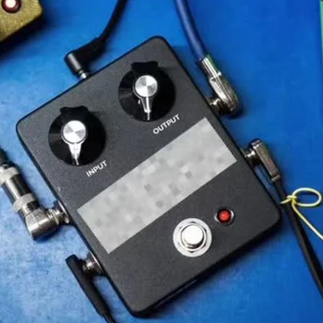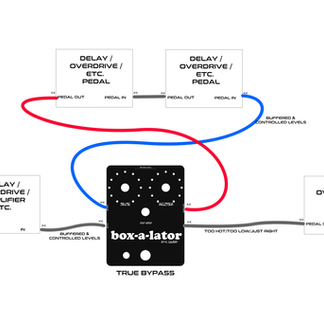box-a-later | My Take On The Dumble "A Box Lator" FX Loop
- Ryan
- Mar 1, 2024
- 8 min read
Updated: Sep 8
Background
Here we go. My first deep dive into a pedal design that draws inspiration from a few different circuits wrapped into one for a design concept I'm looking to achieve. Not surprisingly, this "homework" was initiated by John Mayer's 2021 Dead & Company pedalboard where there was a little black device with two knobs, 4 jacks, and a stomp switch. The crew over at My Stupid Mouth forum began speculation and discussion about what this mystery device might be.

Alejandro (johnmayergear) and I started an offline discussion about this device as well mainly focusing on the name and then it hit us that there was a Dumble thing that Mayer had shown on his Tumblr account a long time ago. The original post has been scrubbed however the internet archive lives on! We also see the device in John's 2013 behind-the-scenes videos. If you read the caption on John's Tumblr post, you'll likely see where I pulled the name box-a-lator from he he.


This got me curious about what was inside so I created a post on The Amp Garage (TAG) to see if there would be any insight. There wasn't much information at the time however there was some additional speculation that it was likely an FX loop like Dumble's Dumbleater. It's not too clear that there were send/return jacks as part of the Dumble device but it was assumed. Around August 16, 2021 Josh @ JHS posted a picture of the device on John's pedalboard, blurring out the name but had the caption "SOMETIMES MYSTERY IS A GOOD THING!" This was cool because now we get some additional details such as the send/return jacks. I'll add the additional high-res photos here as well in this gallery but note that the chronological timeline is a little out of place with the full reveal of "box it later" but it wasn't soon long after the tour started that we used photo enhancing software to determine the name of the pedal (which further confirmed it's probably a clone or something very similar to the Dumble device). Shout out to omega0jm on the MSM forum for keeping track of these details and supplying some of the pictures.
When I started pushing a little more on ampgarage about what is going on with the real Dumble device, the legendary Gil Ayan drops some never-seen-before photos of the a box later. Pasting the photos here for archival needs.
We can learn a few things with this drop of pictures, mainly that there were more than one of these devices made and that inside was an op-amp-based circuitry design. Additional insights from the forum members at the ampgarage observe a bipolar power supply and a B2K potentiometer on the "drive" pot. This was just the spark to ignite my fuel to charge ahead with a design around what we're seeing here. dbharris on ampgarage points out that Dumble might have been inspired by the FX loop op-amp designs in the JCM 900 model and perhaps others. I began collecting schematics for FX loops in the 90's that use op-amps and trying to match them up with the components I can see.

This was about all I could determine from the photos. The circuitry is pretty basic and I believe the "IN" connects to R7 and that's about it. One thing I was curious about is the recovery pot location in the circuit. This seems to line up with traditional Dumbleators however I have not seen that in many op-amp designs. I decided to include it in my design however I was unsure of the value of it. I stuck with 1MA for the time being which would allow the typical impedance but the sweep would be kinda weird.
Designing The box-a-lator
Using the following information, I started to pull together a design concept:
Bipolar power supply.. likely +/- 15v for max headroom on the op-amp.
The DRIVE pot is B2K.
Needs to be a FLAT response if possible.
There appears to be a tantalum capacitor likely for a boost part of the circuit.
The input/output impedance must be friendly for guitar pedals (like how John Mayer is using his) and it also needs to be friendly with tube amp FX impedances.
Fits in a 1590BB or 1590BBS enclosure
The look of it needs to pay homage to Dumble's design and blend with JHS's box it later design.
There is a boost circuit AFTER the return.
Here are some of the circuits I studied.
AionFX L5 Preamp for the +/- 15v power supply.
A bunch of Marshall FX loop circuits (pasting pics below).
One challenge was the impedance to cover tube amps and guitar pedals. The easy solution... TRIM POTS! You'll notice on the Marshall schematics that there was a variable input impedance to the FX loop but the lowest setting was 68k. On my box-a-lator design, I bottomed out the lowest setting using a 68k resistor and used the 1M trim pot to bring the incoming impedance up to 1M. The other trim pot on the return circuit controls the output impedance. The lowest setting is established by R9 (10K) and the trim pot allows up to 1M of output impedance control. Also on the return circuit, the RECOVER pot controls the roll-off of the high end as well so if you want to take the bite out of a tube preamp like a Dumble Overdrive Special, you could use the RETURN pot to further adjust the tone. The default setting on both trim pots is full 1M on to maintain the tone spectrum. I relabeled these trim pots to "drag" pots on the silkscreen since the impedance is also made up of other components in the circuit so I wanted to be accurate with my labeling. It's kinda confusing and I don't fully understand it. Anyway, here is my v1.1/v1.2 schematic. The only difference between 1.1 and 1.2 is that I added a SOIC footprint to allow traditional DIP chips and newer SOIC chips on the same board.
Pay attention if you're here with a V2.x board!




Next up is the layout. I did cram everything together on a single PCB but I felt funny about having the DC-DC converter near the audio portion of the circuit. Even if it operates at 100khz which is way out of the audio range, I still felt uneasy about it so I decided to separate the footswitch and the signal board. With the signal board, I really liked how my 4-layer board for the ATS808 came out and how quiet it was. This project is all about hi-fidelity and low-noise floor so I thought it'd be a good fit here too. Below is the trace layout I landed.

The top and bottom layers are ground pours. The middle two signal layers also have ground poured around the traces so this acts like mini coax cables between each component. The footswitch board is a 2 layer circuit board with no vias. This is the "standard" and there was no real advantage when upgrading this design. Both boards do have the "improved fabrication" technique applied with the vias that you might notice spaced around the board. Those are to connect each layer for a uniform ground signal as well as physically reinforce the layers together.
Assembling the box-a-lator
For the wiring, ground loops can be an issue for some. I recommend building this pedal with isolation jacks like the Neutrik NMJ4HC-S. Future box-a-lator designs may include a ground lift switch for the FX loop but for now, you will have to manually add or cut a ground wire from the SEND/RETURN jacks. Also note that the enclosure is not grounded so you will need to solder a wire to the footswitch lock washer and attach it to the ground on the input jack. This also creates a star-ground scheme so all grounds land in a single place.

The drill template accommodates 1590BB enclosures as well as 1590BBS enclosures. I recommend the 1590BBS enclosure for the additional height so it matches the height of the other pedals next to it. If you're using this device as a tube amp FX loop, size isn't too important but it might still be easier to assemble with the extra height of the 1590BBS.
Soon I'll add the Tayda drill templates once I have a free minute or two.
v1 box-a-lator build info
Here is the v1 BOM info which includes a convenient MOUSER project link.
https://docs.google.com/spreadsheets/d/1aC4ULW50eoGUjiOnjHFqkAqDp1eSRMveEHBwo_skGSQ/edit?usp=sharing
EDIT 3/15/24: Please use a A10K for the recovery pot instead of A1M. This gives greater control for reducing the levels coming back from the FX loop.
Google Photos album for v1 with build photos and research.
v2 box-a-lator build info
Here is the v2 BOM info which includes a convenient MOUSER project link.
https://docs.google.com/spreadsheets/d/1XNznF05JvtYpz4eJ_ME3sPe_uYBTkGx3nRmz-Ebnrlo/edit?usp=sharing
Google Photos album for v2 with build photos.
v2.0 Build notes:
The circuit is modified quite a bit ever since I learned more about the real Dumble "a box later" via JHS's YouTube video here: https://youtu.be/-MLiMJRlC9s?si=Uo5ckPPosEnfLZ_Z&t=479 specifically the screen shot of the guts. This gets us closer to what is in Mayer's "box it later". More info on that illustrating the differences in the future.
I accidentally have the Recovery Boost wired backwards on the PCB. This just means the boost is up all the way to clockwise and "stock" is clockwise. No big deal.
The 2 & 3 pin on the Recovery pot needs to be swapped. Illustrated below. Not a big deal if you don't do the swap because the recovery will act like an impedance control and help roll off your bass which is super helpful in some scenarios.
v2.0 only
Component Selection Notes:
If you're going for a very quiet build, I suggest using metal film resistors. The capacitors in my BOM are specifically chosen for their intended places. For example, the power supply uses solid polymer electrolytic. This is for extremely long service life as well as super low ESR. There is a non-polarized electrolytic for one of the coupling caps and this is a tribute to the original Dumble build where you see a non-polarized axial. Although Dumble likely used a standard TL072 op-amp, I prefer the sound from an OPA2134 which is designed specifically for audio applications.
!!!YOUTUBE BUILD VIDEO COMING SOON!!!
Using the box-a-lator
Well here we are... what the hell are we going to use this device for? Well first... some graphs!

This graph demonstrates the clean and neutral nature of the box-a-lator. With the DRIVE and RECOVER at 100% (unity) and the boost on 0%.

This graph demonstrates the neutral nature of the boost circuit at 100%. Take note on the scale of the dB. For guitar frequencies, the roll-off is negligible.

This graph demonstrates the neutral tone and sliiigggtttt dip in levels going through the FX loop. The cable is a 25-foot cheap cable from Amazon.

This graph demonstrates the advantage of the bipolar (+/-15vdc) power supply. This is using an OPA2134 op-amp. The yellow line is a 6v peak-to-peak incoming signal and the maximum boost before the signal starts clipping which is just shy of 30vdc.
ok ok ok.. now what can we do with this device? I will need to make a video to explain but there are a few things you can do here and I'm sure there are plenty of other use cases..
You can use this device like John Mayer does, which is to attenuate the signal of a HOT signal. Simply connect a short jumper cable between SEND/RETURN and now you can tame a pedal from oversaturating the next pedal but maintaining the uncolored tone.
You can use it in your amp's FX loop like a Dumbleator. Dime your preamp and tame it with this device so you don't oversaturate the power section!
You can use it in your amp's FX loop to add post-preamp effects down long cable runs. Exactly like a Dumblelator would do too!
You can use this device as a neutral buffer or super clean boost. Set the DRIVE/RECOVER to 100% and adjust the boost to taste.
You can add a pedal or a bunch of pedals in the FX loop so you can stomp on the switch and engage multiple pedals through the loop. If you have a TS10 or bluesbreaker with sensitive footswitches, this might be a good fix for you!
I'm sure there are plenty of other use cases. Send me your ideas and I'll them here! It's a great tool.
!!!HOW TO USE THIS PEDAL VIDEO COMING SOON!!!

































































